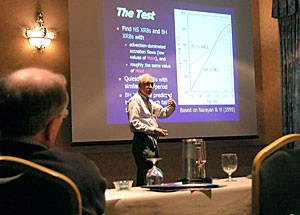Water-filled stemware covers the tables. Chairs are packed tightly over the elaborate carpet in a room full of scientists from around the world, all brought together by a common purpose – to better their understanding of the thing that keeps their glasses on the tables and their chairs on the floor.
More than three dozen leading physicists and astrophysicists met at the Tucson Marriott University Park yesterday for the start of a three-day conference on gravity titled “”Rethinking Gravity: from the Planck scale to the size of the universe.””
Gravity is a phenomenon that has been studied for centuries, but it remains the last force of nature that is yet to be fully understood.
If there was ever an ideal time to remedy this perplexity and to unify gravity with all the other forces, most scientists agree it is now.
The last 10 years have seen the birth of many unique ideas and new experimental discoveries that have prompted scientists to re-evaluate Einstein’s theory of relativity and to decide the proper questions to ask for the next 10 years, said Dimitrios Psaltis, an assistant professor of physics at the UA and a conference organizer.
“”We are at a crossroads now,”” Psaltis said. “”We have new ideas, fresh ideas, weird ideas, and we have experimental results that we cannot understand, so we are trying to put everything together to see where we are going.””
It’s fitting that the UA is holding the conference, which will feature talks ranging in topic from
A schedule of upcoming conference talks and QuickTime streams of the talks can be found at http://www.physics.arizona.edu/gravity
holographic gravity to astrophysical black holes, because the UA probably has the largest theoretical physics program at a university in the United States, Psaltis said.
Although the conference is being held in the spirit of collaboration, scientists are perfectly aware of the competition and pressure in trying to solve the gravity riddle.
“”Anyone who can find the next theory of gravity is going to be the next Einstein,”” said Cliff Burgess, of the Perimeter Institute and McMaster University. “”So there is an enormous premium on being the guy who finds the new thing, or the girl who finds the new thing.””
Burgess said there is a huge amount of competition, which has everyone thinking.
The fundamental problem that has scientists from around the world contending to join the ranks of such household names as Aristotle, Newton and Einstein is a matter of scale.
Gravity, which is the behavior of space and time, is well-understood at large distances – when talking about planets, for instance.
But when scientists attempt to apply it at very small distances, the idea that we can measure space and time breaks down, Burgess said.
When a scientist measures the location of a particle, for instance, the act of measuring itself gives the particle more energy, which causes the particle to gravitate and curve space and time even more, Burgess said.
“”How can you measure space and time accurately if the measuring devices themselves are starting to gravitate?”” Burgess said.
Although what actually occurs at small distances remains a mystery, Burgess conjectures that what will probably be true is that at very small distances, it will not make sense to talk about space and time at all.
“”Something else will happen,”” Burgess said. “”Space and time will only emerge at large distances as some approximate way of thinking about things. Everyone would like to understand what that means, but nobody does.””









